Topics
Category
Era
Northland / Mesaba Transportation Company
Cropped portion of a panoramic view of Mesaba Transportation Company buses (twelve of the eighteen in use at the time) parked with their respective drivers on McKinley Street in North Hibbing, September 5, 1918.
In 1914, miners often walked two miles from their homes in Alice, Minnesota, to their jobs in the iron mines of Hibbing, even during dangerous winters. Former driller and failing car salesman C. Eric Wickman changed that when he decided to use a Hupmobile to transport miners for a small fee: 15 cents for a one-way trip and 25 cents for a round trip. Wickman’s service became one of the earliest examples of intercity busing in the US and, fifteen years later, led to the establishment of the multimillion-dollar Greyhound Bus Corporation.
The demand for a car service around Hibbing in 1914 was too much for one person to manage alone. Soon, Wickman brought in Andrew G. Anderson and Arvid Heed; shortly afterwards, they conscripted competing taxi driver Ralph Bogan. The four partners formed the Hibbing Transportation Company and, by the end of 1915, renamed it the Mesaba Transportation Company.
During these years, the company expanded its service to new towns, including Duluth, and acquired eighteen buses by 1918 to do so. The early vehicles were spartan, offering little in terms of comfort and barely providing shelter from the harsh Minnesota winters. Often, their frames were extended to accommodate more passengers.
Mesaba Transportation Company grew rapidly during World War I; its revenues went from $8000 in 1915 to $16,000 in 1916 and $40,000 by 1918. With the increasing income, Mesaba was able to invest in better vehicles, such as the Fageol Safety Coach, a twenty-passenger bus. Wickman, Anderson, and Edwin Eckstrom established an auxiliary company, the Mesaba Motor Company, in 1919 for the maintenance, repair, and manufacture of buses, including the installation of efficient heating systems.
Passage of the Federal Highway Act of 1921 increased the popularity of bus travel. This legislation funded the paving of thousands of miles of roads, which made bus routes a viable alternative to railways.
In 1922, Wickman and Heed sold their portion of Mesaba Transportation to the other partners. They maintained sole interest in Mesaba Motor, which they moved to Duluth. At this point, Wickman and his associates began acquiring other bus lines, creating a more consistent and streamlined service across the region. They began with the acquisition of a Duluth concern called White Bus Lines, which reached Grand Marais. Wickman also bought a Wisconsin company called Superior White, making the venture an interstate company. By 1925, Wickman’s business was incorporated as Northland Transportation Company.
The rapid acquisition of smaller lines was bolstered by state regulations and licensing. Larger companies like Northland had the financial resources and organizational sophistication to meet standards. Smaller bus ventures that struggled to make the grade found it profitable to sell their concerns to companies like Northland.
Northland spent the late 1920s merging bus line after bus line, including most of Mesaba Transportation Company’s lines. The enormous investment of the Great Northern Railway under Ralph Budd aided this process. Budd saw an opportunity in partnering with bus transportation instead of viewing it as competition. Great Northern thus acquired 80 percent interest in Northland, pumping $240,000 into the company. Wickman retained 20 percent interest. With the railroad’s backing, Northland orchestrated a $2.5 million merger of several bus lines, comprising 150 buses and the better part of 3,000 miles of routes. Ultimately Northland controlled most of Minnesota’s bus lines (apart from the southeastern portion of the state), and provided routes into Wisconsin, the Dakotas, and even Canada.
At the same time that Northland was absorbing much of the state’s bus business, Wickman, Eckstrom, and Wickman’s partner at Northland, Orville Caesar, founded a holding company for Midwestern bus transportation called the Motor Transit Corporation. With the help of Minneapolis investment banker Glenn Traer, this new venture was valued at $10,000,000. It sought to do across the region (and eventually the country) what Northland had done in Minnesota: merge numerous independent bus lines into a single organization. Then, in 1929, Motor Transit bought Northland and all of its interests. It moved its headquarters to Chicago and became the Greyhound Corporation.
Bibliography
Gabrick, Robert. Go the Greyhound Way: The Romance of the Road. Hudson, WI: Iconografix, 2009.
Jackson, Carlton. Hounds of the Road: A History of the Greyhound Bus Company. Bowling Green, OH: Bowling Green University Popular Press, 1984.
Schisgall, Oscar. The Greyhound Story: From Hibbing to Everywhere. Chicago: J. G. Ferguson, 1985.
Walsh, Margaret. “Tracing the Hound: the Minnesota Roots of the Greyhound Bus Corporation.” Minnesota History 49, no. 8. (Winter 1985): 310–321.
Related Resources
Primary
Baum, Arthur W., and John Burton Tigrett. Everything Happens on a Bus. Philadelphia: Curtis, 1946.
Historical sketches and related materials, 1926, 1929
Great Northern Railway records
Manuscripts Collection, Minnesota Historical Society, St Paul
Description: Historical sketches and related miscellany concerning a Great Northern subsidiary that financed and acquired intercity bus lines in Minnesota.
Laurence A. Rossman papers, 1924–1996 (bulk 1925–1955)
Manuscripts Collection, Minnesota Historical Society, St. Paul
Description: Papers of L. A. Rossman, publisher of the Grand Rapids (Minn.) Herald-Review, documenting his interests and involvement in business and civic affairs. Includes pamphlets and essays, correspondence, speeches, reports, financial data, minutes, bus schedules (1924–1929), and other materials containing information about transportation, taxation, banking, forestry, iron mining, education, highway financing, and other issues, and about Rossman's writing and publishing activities. Much of the collection relates to the Greyhound Corporation, to predecessor and related bus companies, and to the history, development, and promotion of inter-city bus systems and travel.
http://www.mnhs.org/library/findaids/00291.xml
Over Minnesota's Scenic Highways, thru Minnesota's Famous Playgrounds: With Safety and Comfort on Northland Buses. Minneapolis: Northland Transportation Company, 1929? Available at the Minnesota Historical Society library as HE5623.Z7 N67 1929.
P892
Historical Sketch of the Hibbing Bus Line, April 15, 1936
Manuscripts Collection, Minnesota Historical Society, St. Paul
Description: An historical sketch (notarized) describing the beginnings of the Hibbing Bus Line in 1914, written by one of the founders and operators.
P1169-20
History of Mesaba Transportation Company, [1930?]
Manuscripts Collection, Minnesota Historical Society, St Paul
Description: A typed carbon copy of a brief history of the Mesaba Transportation Company from 1914 to 1928. Information is given on the founding of the company, owners, stockholders, the buses and routes between Hibbing and other cities in northern Minnesota, reorganizations, and the sale of most of the routes and equipment to the Northland Transportation Company in 1928.
Rossman, L. A. A Romance of Transportation. Grand Rapids, MN: Herald Review, 1940. Available at the Minnesota Historical library as HE5633.M6 R83.
Secondary
Gabrick, Robert. Traveling with Greyhound: On the Road for 100 Years. Hudson, WI: Enthusiast Books, 2014.
Roggero, Alex. Greyhound: A Pictorial Tribute to an American Icon. London: Osprey Automotive, 1995.
Shaw, Douglas V. “Ralph Budd, the Great Northern Railway, and the Advent of the Motor Bus.” Railroad History no. 166: (Spring 1992): 57–79.
Related Audio
MN90: The Road to Greyhound
You can go practically anywhere on a Greyhound bus nowadays, but when two men from Hibbing started the company in 1914, the only route was from Hibbing to Alice and back again. That is, until a new fleet of sleek, gray buses changed everything
All rights reserved
More Information
Related Images
Panoramic view of Mesaba Transportation Company buses and drivers parked on McKinley Street in North Hibbing. In the background are a water tower (far left), the Lincoln School, the St. Louis County Courthouse (center), and a residential area (far right). Aubin Photograph Studio Collection, Hibbing Historical Society.

Mesaba Transportation Company buses and drivers, 1918
Cropped portion of a panoramic view of Mesaba Transportation Company buses (twelve of the eighteen in use at the time) parked with their respective drivers on McKinley Street in North Hibbing, September 5, 1918.
Holding Location
More Information
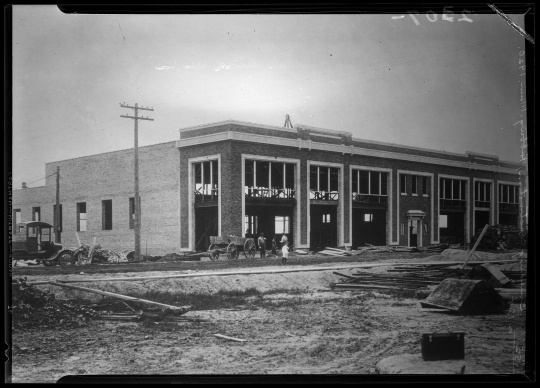
Mesaba Transportation Company garage under construction
The Mesaba Transportation Company garage (North Hibbing) under construction, undated but ca. 1918.
Holding Location
More Information
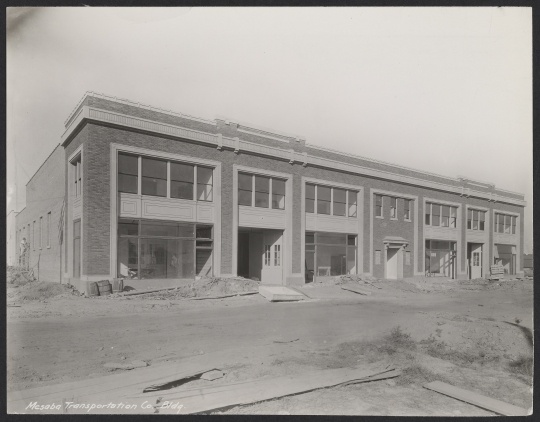
Mesaba Transportation Company garage
Mesaba Transportation Company garage, North Hibbing, 1921.
Holding Location
More Information

Mesaba Transportation Company buses
Panoramic view of Mesaba Transportation Company buses and drivers parked on McKinley Street in North Hibbing. In the background are a water tower (far left), the Lincoln School, the St. Louis County Courthouse (center), and a residential area (far right). Aubin Photograph Studio Collection, Hibbing Historical Society.
Holding Location
More Information
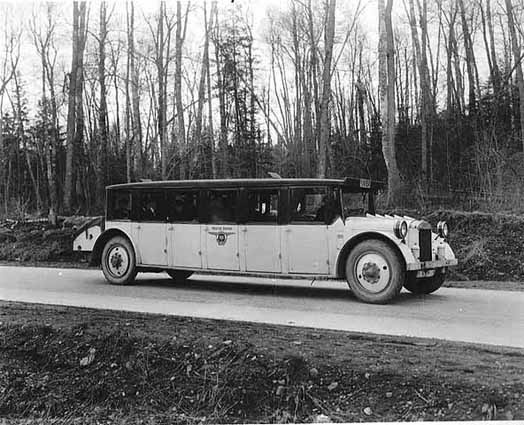
Fageol safety coach (bus)
Fageol safety coach operated by White Bus Lines on a road in St. Louis County, Minnesota,1923.
Holding Location
More Information
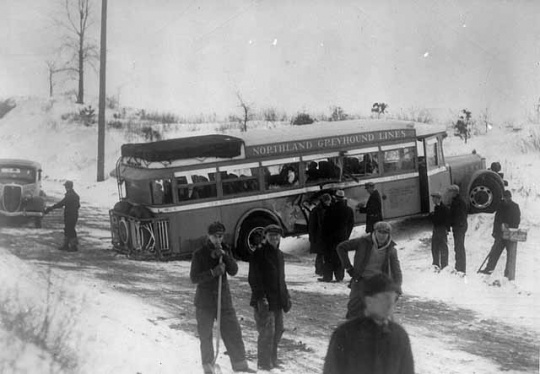
Northland Greyhound bus in a ditch
A Northland Greyhound bus in a ditch, ca. 1925.
Holding Location
More Information
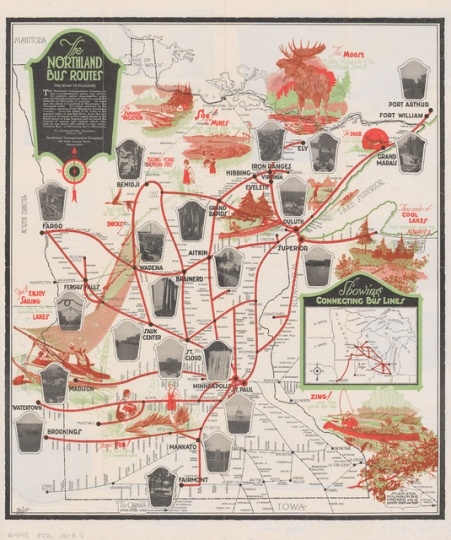
Map of Northland Transportation bus routes
Map of Northland Transportation bus routes, 1928.
Holding Location
More Information
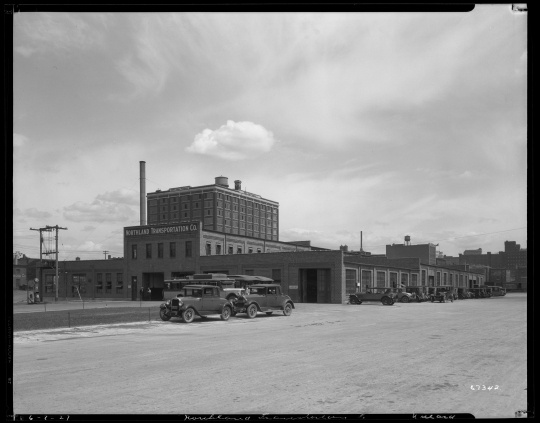
Northland Transportation Company headquarters
The Minneapolis headquarters of the Northland Transportation Company (North Fifth Avenue at Sixth Avenue), June 6, 1927.
Holding Location
More Information

Miniature Northland Transportation Company bus
A miniature version of a Northland Transportation Company bus. Date of manufacture unknown but ca. 1930.
Holding Location
More Information
Related Articles
Turning Point
On December 20, 1924, bus pioneer C. Eric Wickman creates Northland Transportation Company. Drawing on his experience leading the Mesaba Transportation Company, he rapidly acquires small bus lines across Minnesota, making Northland the largest bus venture in the state. Northland’s business model of merging companies provided the blueprint for Greyhound Bus Corporation (which grew out of Mesaba Transportation Company) to consolidate its interests nationally in the late 1920s and 1930s.
Chronology
1914
1915
1919
late 1922
1924
1925
1926
1928
1929
1930
Bibliography
Gabrick, Robert. Go the Greyhound Way: The Romance of the Road. Hudson, WI: Iconografix, 2009.
Jackson, Carlton. Hounds of the Road: A History of the Greyhound Bus Company. Bowling Green, OH: Bowling Green University Popular Press, 1984.
Schisgall, Oscar. The Greyhound Story: From Hibbing to Everywhere. Chicago: J. G. Ferguson, 1985.
Walsh, Margaret. “Tracing the Hound: the Minnesota Roots of the Greyhound Bus Corporation.” Minnesota History 49, no. 8. (Winter 1985): 310–321.
Related Resources
Primary
Baum, Arthur W., and John Burton Tigrett. Everything Happens on a Bus. Philadelphia: Curtis, 1946.
Historical sketches and related materials, 1926, 1929
Great Northern Railway records
Manuscripts Collection, Minnesota Historical Society, St Paul
Description: Historical sketches and related miscellany concerning a Great Northern subsidiary that financed and acquired intercity bus lines in Minnesota.
Laurence A. Rossman papers, 1924–1996 (bulk 1925–1955)
Manuscripts Collection, Minnesota Historical Society, St. Paul
Description: Papers of L. A. Rossman, publisher of the Grand Rapids (Minn.) Herald-Review, documenting his interests and involvement in business and civic affairs. Includes pamphlets and essays, correspondence, speeches, reports, financial data, minutes, bus schedules (1924–1929), and other materials containing information about transportation, taxation, banking, forestry, iron mining, education, highway financing, and other issues, and about Rossman's writing and publishing activities. Much of the collection relates to the Greyhound Corporation, to predecessor and related bus companies, and to the history, development, and promotion of inter-city bus systems and travel.
http://www.mnhs.org/library/findaids/00291.xml
Over Minnesota's Scenic Highways, thru Minnesota's Famous Playgrounds: With Safety and Comfort on Northland Buses. Minneapolis: Northland Transportation Company, 1929? Available at the Minnesota Historical Society library as HE5623.Z7 N67 1929.
P892
Historical Sketch of the Hibbing Bus Line, April 15, 1936
Manuscripts Collection, Minnesota Historical Society, St. Paul
Description: An historical sketch (notarized) describing the beginnings of the Hibbing Bus Line in 1914, written by one of the founders and operators.
P1169-20
History of Mesaba Transportation Company, [1930?]
Manuscripts Collection, Minnesota Historical Society, St Paul
Description: A typed carbon copy of a brief history of the Mesaba Transportation Company from 1914 to 1928. Information is given on the founding of the company, owners, stockholders, the buses and routes between Hibbing and other cities in northern Minnesota, reorganizations, and the sale of most of the routes and equipment to the Northland Transportation Company in 1928.
Rossman, L. A. A Romance of Transportation. Grand Rapids, MN: Herald Review, 1940. Available at the Minnesota Historical library as HE5633.M6 R83.
Secondary
Gabrick, Robert. Traveling with Greyhound: On the Road for 100 Years. Hudson, WI: Enthusiast Books, 2014.
Roggero, Alex. Greyhound: A Pictorial Tribute to an American Icon. London: Osprey Automotive, 1995.
Shaw, Douglas V. “Ralph Budd, the Great Northern Railway, and the Advent of the Motor Bus.” Railroad History no. 166: (Spring 1992): 57–79.










